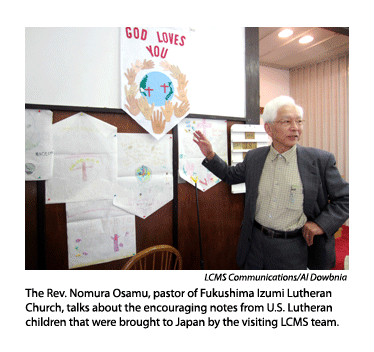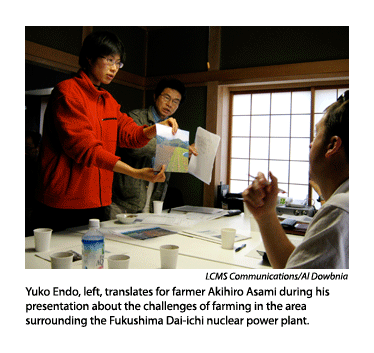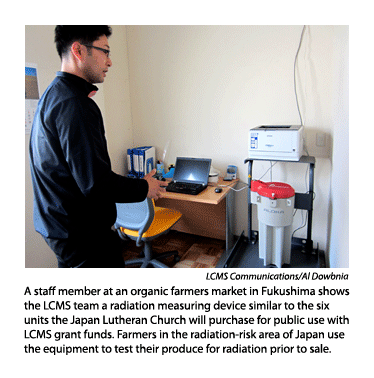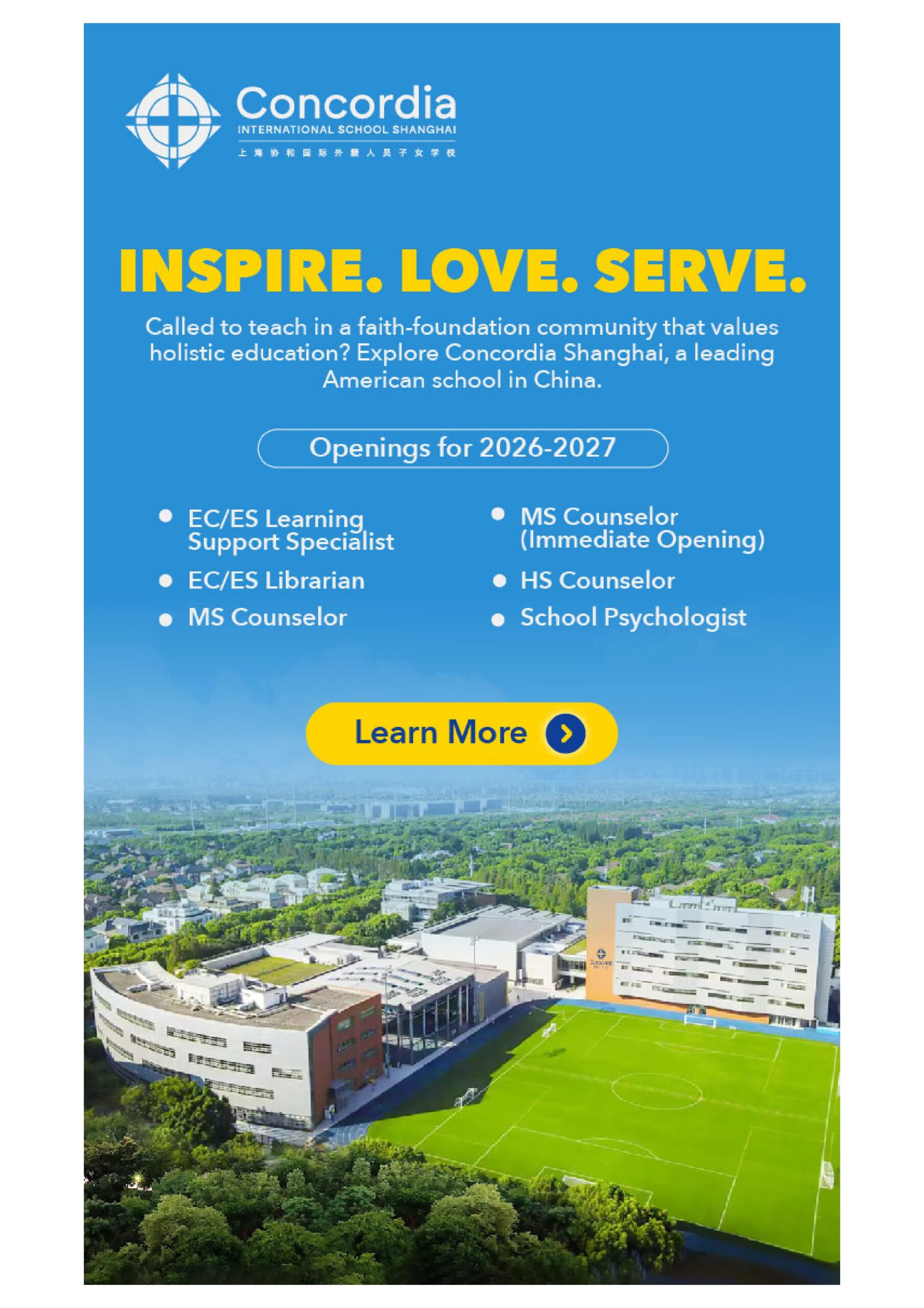By Sarah Schafer
Four LCMS staff members who traveled to Japan Nov. 7-11 report that life in Tokyo has returned to a sense of normalcy following the earthquake, tsunami and nuclear disaster that hit the country in March. But they add that radiation contamination remains a pressing concern 137 miles away in Fukushima, closer to the nuclear disaster.
The Rev. Glenn F. Merritt, director of LCMS Disaster Response with the Synod’s Office of International Mission (OIM); the Rev. Dr. Edward Grimenstein, manager of LCMS Disaster Response; Michelle Cagnin, the facilitator for human care in Asia and the area facilitator for Southeast Asia with LCMS World Mission (OIM); and Al Dowbnia, director of Digital Media with LCMS  Communications, joined the Rev. Masahiro Ando, director of relief work with the Japan Lutheran Church (JLC), reviewing three long-term recovery projects to help those who suffer from Japan’s “invisible disaster.” (To see more photos from the LCMS team’s visit to Japan, click here.)
Communications, joined the Rev. Masahiro Ando, director of relief work with the Japan Lutheran Church (JLC), reviewing three long-term recovery projects to help those who suffer from Japan’s “invisible disaster.” (To see more photos from the LCMS team’s visit to Japan, click here.)
“We keep hearing that radiation is the ‘invisible disaster,’ ” said Dowbnia. “People in the radiation areas feel forgotten, the farmers feel forgotten, they can’t sell their produce.”
More than 2 million people live in the city of Fukushima, 50 miles from the Fukushima Dai-ichi nuclear power plant that news sources call the scene of “the worst nuclear disaster since Chernobyl.”
The LCMS team met with the Rev. Osamu Nomura, pastor of Fukushima Izumi Lutheran Church, to discuss a “kids camp,” one of the three planned recovery projects. The camp, similar to a vacation Bible school, would give children an opportunity to spend a few days outside the radiation risk zone.
“While the physical aspect of taking a few days away out of the radiation risk zone may be beneficial, the psychological effect will be significant,” according to Merritt. At each of seven sites the group visited in Fukushima Prefecture, he said, “we heard people describe their fears of radiation exposure and the way in which the nuclear disaster has affected their communities, jobs, farms and families.”
The team toured an organic farmers market in Fukushima, where local farmers check radiation levels in crops to determine if food can be certified as edible. Most testing is cost-prohibitive for those who own the small farms that make up a  large part of Fukushima’s agricultural landscape.
large part of Fukushima’s agricultural landscape.
With support from the LCMS, the JLC plans to place six radiation monitoring and testing stations throughout Fukushima Prefecture and provide training for station operators.
“Fruit, vegetables or rice can be tested free at these monitoring stations and the farmers will receive a government-recognized certificate to sell or give away their crop,” said Grimenstein.
Aoba-Gakuen (Green Leaf) orphanage in Fukushima will receive one of the radiation monitoring stations. Some 60 children ages 2 to 18 live in five homes operated by the orphanage, which was established after World War II with support from Lutherans.
According to the director of the orphanage, it has been a challenge to obtain healthy food for the children since the disaster because local farmers who once donated food now find it difficult to confirm the safety of their crops. The new monitoring station will be housed in a community center currently under construction on the orphanage property.
The Fukushima Organic Farmers Association also may receive a monitoring station and make it available to area farmers. The association also is interested in training local farmers about agricultural methods to use following nuclear disasters, according to Grimenstein.
Another project, now being finalized by the JLC, will provide children from Fukushima City and Koriyama (also in the radiation at-risk zone) with scholarships to attend Lutheran schools in Tokyo. The scholarships will include support for the family, if necessary, including funding for parents to move to Tokyo to be with their children.
While in Japan, the LCMS team visited Urawa Lutheran School in Tokyo, one of the schools that could accept scholarship students. About a third of the school’s 678 students are Christian, compared w ith 1 percent of Japan’s total population.
ith 1 percent of Japan’s total population.
“Recruitment of potential students will include contacting students who have already been living outside of Fukushima Prefecture since the nuclear disaster or students who have remained living within Fukushima Prefecture, particularly those who have stayed close to the radiation hot zones,” said Merritt.
The LCMS team also visited JLC offices in Tokyo to discuss how the Synod might continue supporting its partner church’s disaster relief. They met with JLC relief Director Ando, President Rev. Yutaka Kumei, General Secretary Rev. Shinri Emoto and Missions Secretary Rev. Mamoru Saito.
Merritt and Cagnin are planning a return trip to Japan in March, which will mark the first-year anniversary of the disaster.
To date, LCMS supporters have given more than $2.3 million for relief efforts in Japan that are expected to continue for years to come. The LCMS awarded more than $1 million to assist with relief and recovery efforts, including those of Japan Lutheran Emergency Relief (JLER), which includes the Japan Lutheran Church, the West Japan Evangelical Lutheran Church, and other church and community leaders.
The LCMS has supported JLER with efforts in hard-hit areas, such as Maehama, Kesenuma, Ishinomaki and Higohinatsushima. The JLC will carry out its three projects in Fukushima apart from the JLER, but with its approval.
To contribute to the Synod’s disaster response in Japan:
- mail checks (noting “Japan Disaster Relief” in the memo line) to LCMS World Relief and Human Care, P.O. Box 66861, St. Louis, MO 63166-6861.
- call toll-free 888-930-4438.
- give online to Japan Disaster Relief (click here).
Any funds not needed for this relief effort will be used for other disaster-response purposes as determined by LCMS World Relief and Human Care. Your gift is tax-deductible to the extent permitted by law.
Sarah Schafer is a freelance writer based in Fairfax, Va.
Posted Nov. 18, 2011




